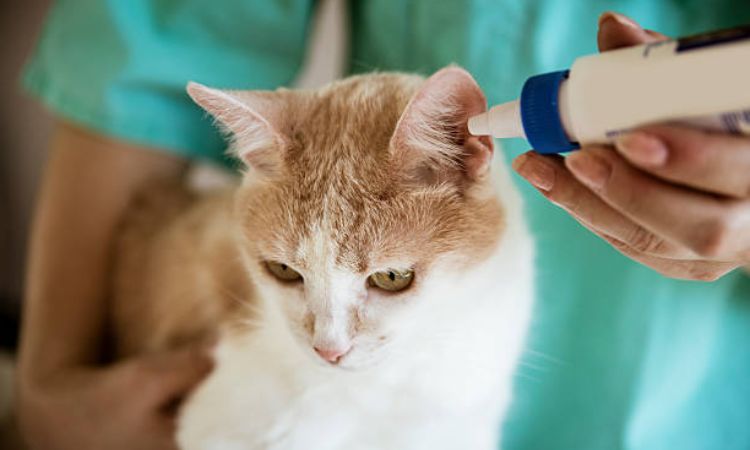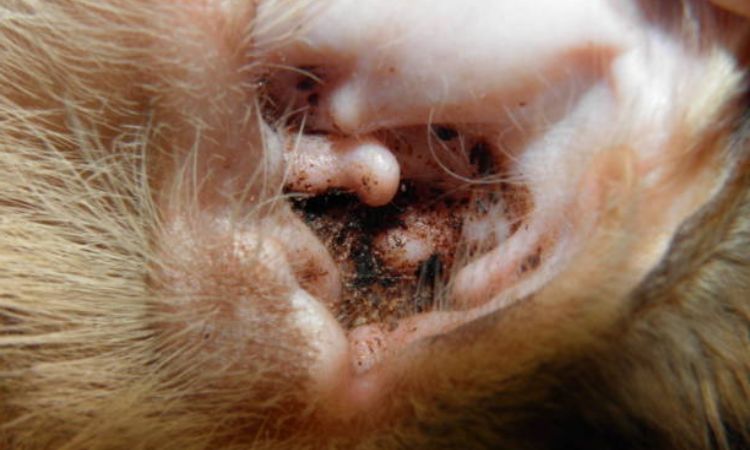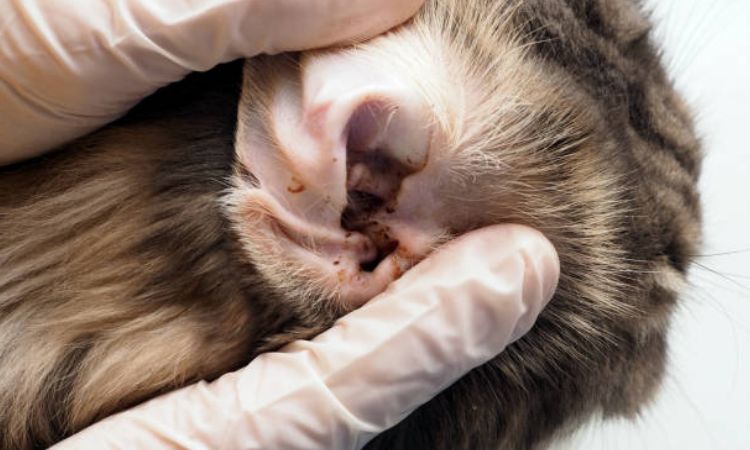If your cat has been scratching its ears nonstop or shaking its head like it’s trying to dislodge an invisible nuisance, ear mites could be the culprits. These tiny, almost microscopic parasites, known as Otodectes cynotis, are surprisingly common—especially in curious kittens and adventurous outdoor cats.
In this guide, Nexus-Pets will help you recognize the telltale signs of ear mites and walk you through safe, effective ways to treat your feline friend right at home.

What Are Cat Ear Mites?
Ear mites, scientifically known as Otodectes cynotis, are tiny, parasitic arachnids that live in the ear canal and sometimes on the surrounding skin of cats. These minuscule pests are highly contagious among animals, especially cats, and are a common cause of ear irritation.
Cats typically contract ear mites through direct contact with an infested animal, such as other cats, dogs, or even wildlife. Indirect transmission is also possible when a cat comes into contact with contaminated bedding, grooming tools, or shared living environments like shelters and boarding facilities.
While ear mites are not life-threatening, they can cause significant discomfort and health issues. Infestations often lead to intense itching, scratching, head shaking, and inflammation of the ear canal. If left untreated, ear mites can cause secondary infections, damage to the eardrum, and chronic ear problems, making early detection and treatment essential for your cat’s health.
Common Signs of Ear Mites in Cats
Ear mites can cause significant discomfort to cats, and recognizing the symptoms early is crucial for prompt treatment. The most noticeable signs include:
- Head shaking and ear scratching: Cats infested with ear mites often shake their heads repeatedly and scratch at their ears to relieve persistent itching. These behaviors may occur almost continuously in severe infestations.
- Dark, crumbly ear discharge: A telltale sign is a buildup of dark brown or black debris in the ear canal, often described as resembling coffee grounds. This material consists of mites, their eggs, and dried secretions.
- Strong odor from the ears: Infested cats may develop a foul smell emanating from the ears, usually due to debris accumulation or secondary bacterial infections.
- Redness, swelling, or sores around the ears: The skin surrounding the ears may become inflamed or irritated from constant scratching, sometimes leading to scabs, sores, or hair loss.
- Behavioral changes: Cats suffering from ear mites may appear restless, irritable, or unusually agitated. Some may show decreased appetite or lethargy due to discomfort.
Recognizing these signs early and consulting a veterinarian for proper diagnosis and treatment can prevent complications such as secondary infections, severe inflammation, or even damage to the ear canal.

How to Confirm If Your Cat Has Ear Mites
Confirming an ear mite infestation involves careful observation at home, followed by a professional diagnosis when necessary. Here’s how to proceed:
Visual Home Inspection
Begin by gently examining your cat’s ears with a flashlight or in a well-lit area. Look for dark, crumbly debris resembling coffee grounds, redness, swelling, or excessive wax buildup. You may also notice your cat scratching or shaking its head frequently. Using a cotton swab, you can collect a small amount of ear material to better observe any tiny, fast-moving mites, but avoid inserting the swab too deep into the ear canal.
When to Seek a Veterinarian’s Confirmation
While home inspection can indicate a possible infestation, a veterinarian can provide definitive confirmation. They may perform a microscopic examination of ear debris, allowing them to see mites or their eggs clearly. This ensures the correct diagnosis and rules out other causes of ear irritation.
Key Differences Between Ear Mites and Other Ear Infections
Ear mites can be distinguished from bacterial or yeast infections by the presence of tiny, moving parasites and dark debris, whereas infections often produce thicker, yellowish discharge with a strong odor but no visible mites. Ear infections may also cause similar itching, so professional evaluation is essential to choose the right treatment.
You may also be interested in: Can cat lice transfer to humans
Safe Home Treatments for Cat Ear Mites
1. Gentle Ear Cleaning Before Treatment
Before applying any medication, it’s essential to clean your cat’s ears carefully. Use a soft cotton ball or gauze dampened with a veterinarian-approved ear cleanser to remove excess wax, debris, and dirt. Avoid using cotton swabs deep inside the ear canal, as this can push debris further in or damage delicate structures. Gentle cleaning ensures that topical treatments can reach the ear mites directly and increases the effectiveness of the medication.
2. Over-the-Counter Ear Mite Treatments
Several OTC products are available for cat ear mite infestations, including drops, ointments, and sprays. Look for formulas containing ingredients such as ivermectin or milbemycin, which are effective against mites at various life stages. Apply the medication according to package instructions, usually a few drops directly into the ear canal once or twice daily for the recommended duration. Always monitor your cat for any adverse reactions and consult a veterinarian if symptoms persist.
3. Naturally Supportive Remedies
In addition to conventional treatments, natural remedies can provide soothing relief and support healing:
- Olive oil: Can help smother mites while softening ear debris for easier removal.
- Coconut oil: Offers antimicrobial properties and helps reduce irritation.
- Mineral oil: Sometimes used to suffocate mites, but only in small amounts and with caution.
Precautions: Never use essential oils or home remedies that are toxic to cats. Always dilute oils appropriately and avoid putting excessive liquid into the ear canal, which can worsen irritation or cause fluid buildup.
4. Step-by-Step Guide to Safe Application at Home
- Wash your hands thoroughly before touching your cat’s ears.
- Clean the outer ear gently using a vet-approved cleanser.
- Apply the chosen treatment (OTC or natural remedy) carefully, following the recommended dosage.
- Massage the base of the ear lightly to distribute the medication evenly.
- Wipe away any excess solution with a soft cloth or cotton pad.
- Reward your cat with treats and gentle praise to reduce stress.
- Repeat the process according to the product instructions until the infestation is resolved.
5. Treating All Household Pets
Ear mites are highly contagious. If you have multiple cats, dogs, or other susceptible animals, it’s critical to treat every pet in the household, even if they show no visible symptoms. This prevents reinfestation and ensures that the mites are completely eradicated from your home environment. Combine treatment with thorough cleaning of bedding, furniture, and shared areas to further reduce the risk of recurrence.

When to See a Veterinarian
- Persistent or worsening symptoms: Scratching, head shaking, or ear tilting that doesn’t improve with home care.
- Severe ear damage: Bleeding, open sores, or strong foul odor from the ears.
- Secondary infections: Redness, swelling, pus, or crusty debris indicating bacterial or yeast infections.
- Need for prescription treatment: Strong oral or topical medications required when over-the-counter remedies fail.
Takeaway: Seek veterinary care promptly to relieve discomfort and prevent complications.
To ensure your cat’s health and happiness, it’s essential to stay vigilant for any signs of ear mites. Early detection and proper treatment are key to preventing discomfort and potential complications. Remember, a healthy cat is a happy cat, and taking good care of their ears is a crucial part of responsible pet ownership.






